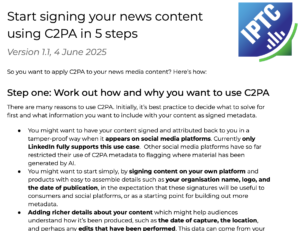Categories
Archives
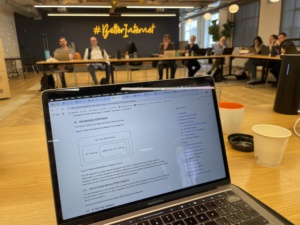
The IPTC participated in a “design team” workshop for the Internet Engineering Task Force (IETF)’s AI Preferences Working Group. Brendan Quinn, IPTC Managing Director attended the workshop in London along with representatives from Mozilla, Google, Microsoft, Cloudflare, Anthropic, Meta, Adobe, Common Crawl and more.
As per the group’s charter, “The AI Preferences Working Group will standardize building blocks that allow for the expression of preferences about how content is collected and processed for Artificial Intelligence (AI) model development, deployment, and use.” The intent is that this will take the form of an extension to the commonly-used Robots Exclusion Protocol (RFC9309). This document defines the way that web crawlers should interact with websites.
The idea is that the Robots Exclusion Protocol would specify how website owners would like content to be collected, and the AI Preferences specification defines the statements that rights-holders can use to express how they would like their content to be used.
The Design Team is discussing and iterating the group’s draft documents: the Vocabulary for Expressing AI Usage Preferences and the “attachment” definition document, Indicating Preferences Regarding Content Usage. The results of the discussions will be taken to the IETF plenary meeting in Madrid next week, and
Discussions have been wide-ranging and include use cases for varying options of opt-in and opt-out, the ability to opt out of generative AI training but to allow search engine indexing, and the difference between preferences for training and preferences for how content can be used at inference time (also known as prompt time or query time, such as RAG or “grounding” use cases) and the varying mechanisms for attaching these preferences to content, i.e. a website’s robots.txt file, HTTP headers and embedded metadata.
The IPTC has already been looking at this area and defined a data mining usage vocabulary in conjunction with the PLUS Coalition in 2023. There is a possibility that our work will change to reflect the IETF agreed vocabulary.
The work also relates to IPTC’s recently-published guidance for publishers on opting out of Generative AI training. Hopefully we will be able to publish a much simpler version of this guidance in the future because of the work from the IETF.
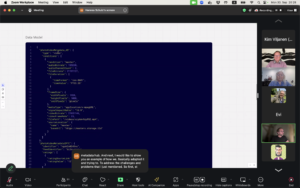
The IPTC Video Metadata Working Group has released version 1.6 of its Video Metadata Hub standard, including terms for rights usage, language, and content created by Generative AI models.
New properties
-
Rights Usage Terms: The licensing parameters of the video expressed in free text. (Aligned with the equivalent term in IPTC Photo Metadata.)
Changed properties
-
Language: Changed label and description to reflect that this represents the main language of the video. (Previously the term was called “language version”).
-
Source (Supply Chain): Changed description to reflect that changes made be made by a system (such as a Generative AI engine) as well as a person or organisation.
The specification for Video Metadata Hub is separated into two parts: IPTC Video Metadata Hub properties and IPTC Video Metadata Hub mappings showing how to apply these core properties in many existing video standards.
There is also a JSON Schema representation of Video Metadata Hub, which is used by some large media companies in manageing their video content. The 1.6 version of the JSON schema reflects the latest changes.
The Video Metadata Hub User Guide and Video Metadata Hub Generator tool have also been updated to include the changes in version 1.6.
Please feel free to discuss the new version of Video Metadata Hub on the public iptc-videometadata discussion group, or contact IPTC via the Contact us form.
The latest version of NewsML-G2, version 2.35 has been released, adding support for the status of events.
Approved by the IPTC Standards Committee at the IPTC Spring Meeting, on 16th May, the new version adds a property eventStatus which matches the equivalent property in ninjs that was added in version 3.0.
eventStatus, within the eventDetails block, describes the status of an actual event – as opposed to occurenceStatus, which conveys the status of how likely it is that a future event will occur, and coverageStatus, which conveys the planned news coverage of a news event.
The recommended controlled vocabulary for eventStatus is http://cv.iptc.org/newscodes/eventstatus, which currently contains the terms “scheduled“, “in progress“, “completed“, “postponed” and “canceled“.
IPTC Catalog updated to version 41
The IPTC Catalog, the master list of internally- and externally-managed controlled vocabularies used and referenced by NewsML-G2, has been updated to version 41. It adds the PLUS Licence Data Format vocabulary, used extensively in IPTC Photo Metadata and now in other standards through the introduction of the Data Mining vocabulary.
The latest catalog is available at http://iptc.org/std/catalog/catalog.IPTC-G2-Standards_41.xml (note the plain http URL scheme. We don’t link directly to it here because clicking the link may trigger browser warnings about moving from https to http URLs.)
Find out more about NewsML-G2 2.35
All information related to NewsML-G2 2.35 is at https://iptc.org/std/NewsML-G2/2.35/.
The NewsML-G2 Specification document has been updated to cover the new version 2.35.
Example instance documents are at https://iptc.org/std/NewsML-G2/2.35/examples/.
Full XML Schema documentation is located at https://iptc.org/std/NewsML-G2/2.35/specification/XML-Schema-Doc-Power/
XML source documents and unit tests are hosted in the public NewsML-G2 GitHub repository.
The NewsML-G2 Generator tool has also been updated to produce NewsML-G2 2.35 files using the version 41 catalog.
For any questions or comments, please contact us via the IPTC Contact Us form or post to the iptc-newsml-g2@groups.io mailing list. IPTC members can ask questions at the weekly IPTC News Architecture Working Group meetings.
For more information, contact the IPTC News Architecture Working Group via the public NewsML-G2 mailing list.

The IPTC is excited to announce the latest updates to ninjs, our JSON-based standard for representing news content metadata. Version 3.1 is now available, along with updated versions 2.2 and 1.6 for those using earlier schemas.
These releases reflect IPTC’s ongoing commitment to supporting structured, machine-readable news content across a variety of technical and editorial workflows.
What is ninjs?
ninjs (News in JSON) is a flexible, developer-friendly format for describing news items in a structured way. It allows publishers, aggregators, and news tech providers to encode rich metadata about articles, images, videos, and more, using a clean JSON format that fits naturally into modern content pipelines.
What’s new in ninjs 3.1, 2.2 and 1.6?
The new releases add a new property for the IPTC Digital Source Type property, which was first used with the IPTC Photo Metadata Standard but now used across the industry to declare the source of media content, including content generated or manipulated by a Generative AI engine.
The new property (called digitalSourceType in 3.1 and digitalsourcetype in 2.2 and 1.6 to match the case conventions of each standard version) has the following properties:
- Name: the name of the digital source type, such as “Created using Generative AI”
- URI: the official identifier of the digital source type from the IPTC Digital Source Type vocabulary or another vocabulary, such as http://cv.iptc.org/newscodes/digitalsourcetype/trainedAlgorithmicMedia (the official ID for generative AI content)
- Literal: an optional way to add new digital source types that are not part of a controlled vocabulary.
IPTC supports multiple versions of ninjs in parallel to ensure stability and continuity for publishers and platforms that depend on long-term schema support.
The new property is part of the general ninjs schema, and so can be used in the main body of a ninjs object to describe the main news item and can also be used in an “association” object which refers to an associated media item.
Access the schemas
All versions are publicly available on the IPTC website:
ninjs generator and user guide
The ninjs Generator tool has been updated to cover the latest versions. Fill in the form fields and see what that content looks like in ninjs format. You can switch between the schema versions to see how the schema changes between 1.6, 2.2 and 3.1.
The ninjs User Guide has also been updated to reflect the newly added property.
Why it matters
As the news industry becomes increasingly reliant on metadata for content distribution, discoverability, and rights management, ninjs provides a modern, extensible foundation that supports both human and machine workflows. It’s trusted by major news agencies, technology platforms, and AI developers alike.
Get involved
We welcome feedback from the community and encourage you to share how you’re using ninjs in your own products or platforms. If you would like to discuss ninjs, you can join the public mailing list at https://groups.io/g/iptc-ninjs.
If you’re interested in contributing to the development of IPTC standards, join us!

“As content becomes commoditised, there will be a trend towards authentic, human-created work,” said Scott Belsky at the 2025 Content Authenticity Summit, held last week on Roosevelt Island, New York.
Over 200 authenticity experts from over 150 companies joined together at the Cornell Tech campus in New York City on Wednesday 4th June to share the latest work of those implementing C2PA in the industry.
The theme of the event was real-world implementation of C2PA and spreading the word about Content Credentials, the user-facing brand of the C2PA technology.
The event was co-presented by IPTC along with the Content Authenticity Initiative (CAI) and the Coalition for Content Provenance and Authenticity (C2PA)
Highlights were:
- The launch of the C2PA Conformance programme, which will allow device and software implementers to be able to obtain certificates on the official C2PA Trust List (after the current Temporary Trust List is shut down later in 2025)
- A talk from Bruce MacCormack of CBC / Radio Canada, Chair of the IPTC Media Provenance Committee, on how the media industry is implementing C2PA, and the importance of publisher branding and organisational stamping of content at publish time to prevent brand hijacking and misattribution of news content
- An in-depth discussion of the IPTC Origin Verified News Publisher programme, including the launch of the IPTC guidance document helping news publishers to implement C2PA
- Another deep-dive workshop looking at which metadata fields should be included in C2PA-signed content. The discussion covered both metadata about the publisher and metadata about the content itself.
- Eight simultaneous tracks of breakout sessions covering device conformance, implementation in the news industry, real-world deployments on Amazon Web Services, work on standardisation with ISO and other bodies,
- A fast-paced and wide-ranging presentation from UC Berkeley professor Hany Farid on the importance of authenticity and the difficulty of keeping up with deepfake detection in our world of ever-improving generative AI models
- The many and varied discussions among attendees around their own effort to implement C2PA technology within their newsrooms
The most common feedback that we heard from attendees was that participants would have liked to be at all of the breakout sessions at the same time!
The event was held under the Chatham House Rule, which means that detailed recordings will not be available, although anonymised workshop summaries will soon be made available to attendees.
For more information about C2PA, the Media Provenance Committee or the Verified News Publisher List, please contact IPTC directly.
The IPTC has released a guide helping news organisations to sign their news content using C2PA technology.
The guidance was launched at today’s Content Authenticity Summit in New York, co-hosted by IPTC along with the Content Authenticity Initiative and the Coalition for Content Provenance and Authenticity (C2PA).
The guide walks publishers and broadcasters through the steps of evaluating and understanding why they should want to implement content provenance at their organisation, and what they aim to achieve. The guide suggests some use cases and reasons that media organisations might want to consider while planning their implementation.
Next, the guide walks through how publishers can obtain a certificate from one of our Certificate Authority partners; submitting the certificate to the Verified News Publisher list, and signing content using your publisher certificate.
The IPTC Media Provenance Committee will adapt the guide over the coming months as the procedure evolves.
For questions on the guidelines or for any other issues regarding the IPTC Origin Verified News Publishers List, please contact IPTC.
The International Press Telecommunications Council (IPTC) is proud to co-host the 2025 Content Authenticity Summit, along with the Coalition for Content Provenance and Authenticity (C2PA) and the Content Authenticity Initiative (CAI). The event will be held tomorrow, Wednesday 4 June at the Cornell University campus on Roosevelt Island, New York City.
The Content Authenticity Summit will convene over 200 of the world’s foremost experts on digital content provenance including implementers, creators, and policymakers for a one-day series of presentations, panels, breakout sessions, and hands-on demonstrations to highlight the latest developments in this essential and fast-moving space.
The Summit, presented by the Content Authenticity Initiative, the Coalition for Content Provenance and Authenticity, and the International Press Telecommunications Council, will highlight current opportunities and challenges focused on driving broad awareness and adoption of Content Credentials.

Brendan Quinn, Managing Director of IPTC, will be hosting two workshops at the Content Authenticity Summit.
Many other IPTC members will also be represented:
- Adobe will have many representatives at the event, including Andy Parsons, Eric Scouten, Pia Blumenthal and Leonard Rosenthol
- Bruce MacCormack of CBC / Radio Canada, Chair of the Media Provenance Committee, will speak about C2PA adoption in the news media
- Helge O. Svela, CEO of Media Cluster Norway will co-host workshops on C2PA in the news industry.
- AFP and IMATAG will present a case study on their project to digitally sign content
- Charlie Halford of the BBC will co-host the workshop on C2PA metadata in the news industry
- Will Kreth of HAND Identity will be speaking about how provenance protects the identities of athletes and entertainers
- Sherif Hanna of Google will be speaking about the forthcoming C2PA Conformance process.
Other speakers include representatives from Meta, LinkedIn, OpenAI, Partnership on AI and Nikon.
We will report on the event later this week. If you’re attending, come and say hello to our members and to IPTC Managing Director Brendan Quinn.
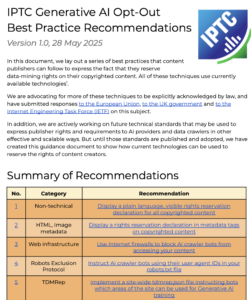
The IPTC has released a set of guidelines expressing best practices that publishers can follow to express the fact that they reserve data-mining rights on their copyrighted content.
All of the recommended techniques use currently available technologies. While the IPTC is advocating both for better acknowledgement in law of current techniques and for clearer, more stable and more scalable techniques for expressing data-mining opt-out, it is important to remember that opt-out can be expressed today, and that publishers shouldn’t wait for future standards to emerge if they want to control data mining rights on their copyrighted content.
Summary of the recommendations
For full detail, please view the PDF opt-out best practices guidelines. A summary of the guidance is provided below.
-
Display a plain-language, visible rights reservation declaration for all copyrighted content
To ensure no misrepresentation, ensure that copyright and rights reservations are plainly displayed to human readers. -
Display a rights reservation declaration in metadata tags on copyrighted content
Using schema.org, the IPTC Photo Metadata Standard and/or IPTC Video Metadata Hub, the same human-readable copyright notice and usage terms should be attached to media content where possible. -
Use Internet firewalls to block AI crawler bots from accessing your content
To ensure that crawlers that ignore robots.txt and other metadata cannot access your content, publishers can employ network-level protection to block crawler bots before they can reach your content. -
Instruct AI crawler bots using their user agent IDs in your robots.txt file
Seemingly the simplest method, this is actually one of the most difficult because each AI system’s crawler user-agent must be blocked separately. -
Implement a site-wide tdmrep.json file instructing bots which areas of the site can be used for Generative AI training
The Text and Data Mining Reservation Protocol can and should be used, in combination with other techniques. -
Use the trust.txt “datatrainingallowed” parameter to declare site-wide data mining restrictions or permissions
The trust.txt specification allows a publisher to declare a single, site-wide data mining reservation with a simple command:datatrainingallowed=no. Sites that already use trust.txt should add this parameter if they want to block their entire site from all AI data training. -
Use the IPTC Photo Metadata Data Mining property on images and video files
Announced previously by the IPTC and developed in collaboration with the PLUS Coalition, the Data Mining property allows asset-level control of data mining preferences. An added benefit is that the opt-out preferences travel along with the content, for example when an image supplied by a picture agency is published by one of their customers. -
Use the CAWG Training and Data Mining Assertion in C2PA-signed images and video files
For C2PA-signed content, a special assertion can be used to indicate data mining preferences. -
Use in-page metadata to declare whether robots can archive or cache page content
HTML meta tags can be used to signal to AI crawlers what should be done with content in web pages. We give specific recommendations in the guidelines. -
Use TDMRep HTML meta tags where appropriate to implement TDM declarations on a per-page basis
The HTML meta tag version of TDMRep can be used to convey rights reservations for individual web pages. -
Send Robots Exclusion Protocol directives in HTTP headers where appropriate
X-Robots-Tag headers to HTTP responses can be used alongside or instead of in-page metadata. -
Use TDMRep HTTP headers where appropriate to implement TDM declarations on a per-URL basis
TDMRep also has an HTTP version, so we recommend that it is used if the top-level tdmrep.json file cannot easily convery asset-level opt-out restrictions.
Feedback and comments welcome
The IPTC welcomes feedback and comments on the guidance. We expect to create further iterations of this document in the future as best practices and opt-out technologies change.
Please use the IPTC Contact Us form to provide feedback or ideas on how we could improve the guidance in the future.
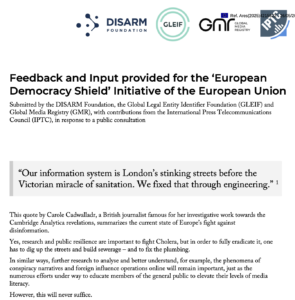
The IPTC has provided input to a submission made by the Global Media Registry to the European Commission’s European Democracy Shield consultation.
The GMR submission discusses the value of organisational identification:
The Importance of Identification and Attribution
Unambiguous attribution is in the best interest of anyone doing honest business. It is also a key requirement for consumer protection.
Not surprisingly, to “Know your Supplier” (KYS) and to “Know your Customer” (KYC) have become essential principles of securing supply chains in almost every industry. In turn, bad actors can capitalize on the absence of clear attribution by faking the identity of brands, vendors or buyers to deceit and to cheat – and to get away with it.
Exactly this happens currently in the field of disinformation, as far as the phenomenon of so-called “Doppelgangers” is concerned. It refers to anonymous imposters falsely claiming to be – among others – DER SPIEGEL, Le Monde, CBC/Radio-Canada, the BBC or CNN, to publish content online that would never appear in either of those highly acclaimed news outlets.
The C2PA specification, and IPTC’s efforts to implement it in the media industry through the IPTC Origin Verified News Publishers List, are recommended as critical means to identify media organisations in a way that is tamper-evident and traceable. Other means of identifying organisations mentioned in the paper include the Legal Entity Identifier (LEI), Global Media ID (which is promoted by Global Media Registry) and International Standard Content Code (ISCC).
The paper concludes:
As a response to the World Financial Crisis 2008/09, the Financial Stability Board of the G20 established a global system of legal entity identifiers, and eventually GLEIF, in order to fix a number of apparent vulnerabilities of the financial sector.
The European Commission should follow this example when designing the ‘Democracy Shield’ and support a global system of identification to fix a number of equally visible vulnerabilities of our shared information space.
Global Media Registry, a liaison partner of the IPTC, is one of the organisations behind the forthcoming ISO specification for a Global Media Identifier (GMI). The specification is currently going through the ISO standardisation process as ISO IWA 44:2025. The IPTC and some IPTC member organisations have participated in the drafting process.
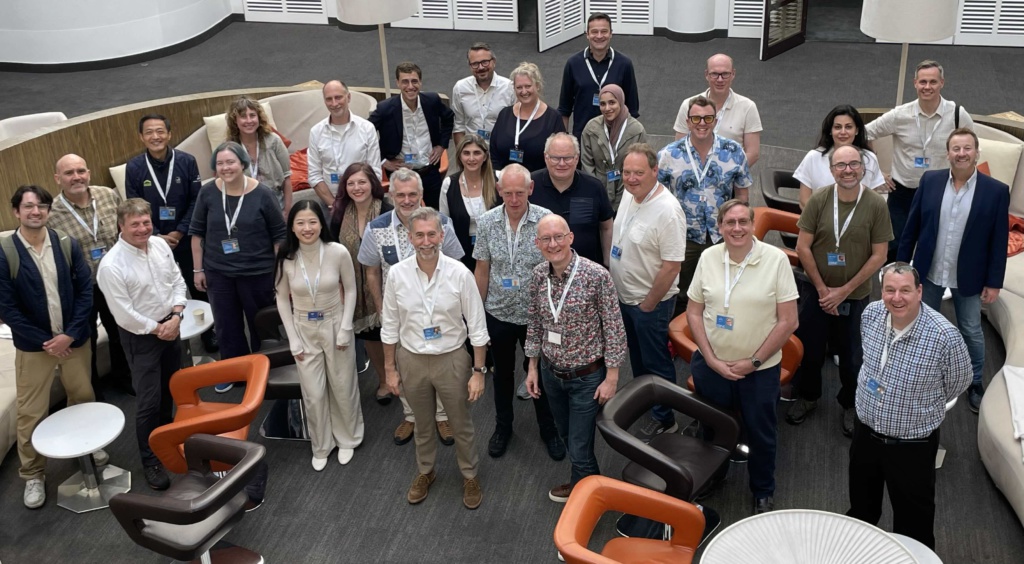
Over 60 senior technology, data and editorial staff from 43 top media companies around the world met in Juan les Pins, France and online for the IPTC Spring Meeting 2025.
Representatives from AP, AFP, BBC, Bloomberg, Getty Images, New York Times, Sinclair Broadcasting Group, Radio New Zealand, Broadcast Solutions Group, Qatar News Agency, Xinhua News Agency, Progress Software, Data Language / DataGraphs, National Geographic Society, OrangeLogic, Trufo.ai, Deutsche Welle, Profium, Athens Technology Centre and more joined us in Antibes. We discussed and shared best practices on AI in media, content provenance, knowledge graphs, AI opt-in and opt-out, and many other topics.
Highlights included:
- Julie McVey from the National Geographic Society speaking about a proof-of-concept project they undertook with their DAM vendor OrangeLogic and provenance technology provider Trufo to digitally sign their archive content
- Paul Wilton from Data Language showing how their DataGraphs product can be used to visualise sports information and link key moments to video clips, all based on IPTC’s Sport Schema model
- Invited guest Benjamin Sabbah from Reporters Without Borders speaking about the Journalism Trust Initiative, leading to a discussion about how we can create a vehicle for metadata about publishing organisations as well as metadata about individual content items
- Reports from the NewsML-G2 / News Architecture Working Group, the News in JSON Working Group and the Photo Metadata Working Group
Day 1 was held in conjunction with the CEPIC 2025 meeting, where we held panels about opt-in and opt-out for Generative AI training, C2PA and media provenance, blockchains for image archives and a hands-on workshop on photo metadata.
Members held the sort of productive discussions, debates and collaborations that can only happen in a face-to-face meeting.
